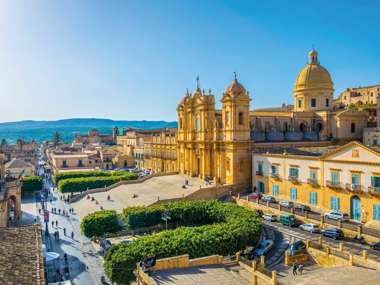A personal account from Secret Sicily
Eleven years ago I visited Sicily and decades after my first visit I still find it a captivating place. A charming and romantic island, as a keen photographer what also captured the attention of my lenses are the terracotta walls, the colourful clothes hanging outside to dry in the warm weather, dramatic Mount Etna, lemon trees and the flavours of delicious Sicilian food and wine.
Sicily has a rich and unique history and culture; experience art, music, literature, cuisine and architecture on our varied Secret Sicily tour - perfect choice for those who would like to see this beautiful island from a different point of view and would like to explore off-the-beaten-track and also for Inspector Montalbano’s fans who wish to visit some key filming locations of this great TV series.
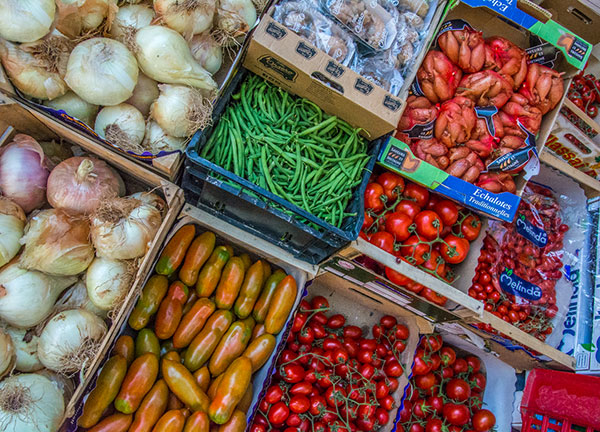
Acireale is an elegant Baroque coastal town rising upon a hill overlooking the Ionian Sea and at the foot of Mount Etna. Considered one of the most beautiful seaside towns in Sicily, built in an area famous for its natural beauty; The Timpa nature reserve is where you can enjoy a beautiful panoramic view down to the Riviera of the Ciclopi.

Continuing up the slopes of Etna, an experience not to be missed is a train journey from Linguaglossa town to Randazzo to explore and appreciate the volcanic scenery of Mount Etna. Mount Etna is Sicily’s most prominent landmark; the tallest active volcano in Europe, and one of the most active in the world.
The town of Randazzo is a medieval town built almost entirely of lava stone and despite the damage suffered during the war the town has preserved its distinctive appearance. The most impressive building for me was Santa Maria church that has been made entirely by lava stone.
Noto caught my eye, my camera lenses and a space on my 'must-see list' when in Sicily; gaining the highlight of the itinerary status and made me feel like if I was photographing a film set.

Noto is a pleasant and picturesque little town, with an elegant walkway formed by Baroque palaces and churches. Wander around the narrow streets and admire the golden-coloured stone buildings, the beautiful facades and well decorated balconies. At the exuberant Baroque Palazzo Nicolaci you will be able to find one of the fanciest balconies, decorated with chubby cherubs and beasts.
Near Noto you will find a charming 18th-century country house called Villa Favorita, a truly hidden gem. This historic hotel offers the charm and class of the Sicilian Baroque and it is the ideal place for a stay just a few minutes from Noto and the sea.
Villa Favorita was born from the restauration of the property of the Di Lorenzo barons of Granieri marquis of Castelluccio family. At this day the villa is still run by direct descendants of the family. The Villa is the result of a family dream, love, dedication and a restauration which had the main objective of saving the original framework and structure on the basis of what the Italian Ministry of Cultural Heritage guidelines were. Each and every room is absolutely unique and offers all the comforts you would expect.
Dating back to the 4th century AD the Roman floor mosaics at the Villa del Tellaro may not be the most extensive in Sicily, but they are exquisite and well preserved. As this is a less-visited archaeological site, it is likely you will be blessed with having the place to yourself, enjoying the quiet location among the lemon groves.
Marzamemi is one of Sicily's prettiest seaside fishing villages at Italy's southernmost point. The charm of this quaint village lies in its history that flows from its buildings. Marzamemi started as a town for tuna fishing and packing, and continues in an artisanal form today. Here it seems you can really go back in time and enter into ordinary people’s life.
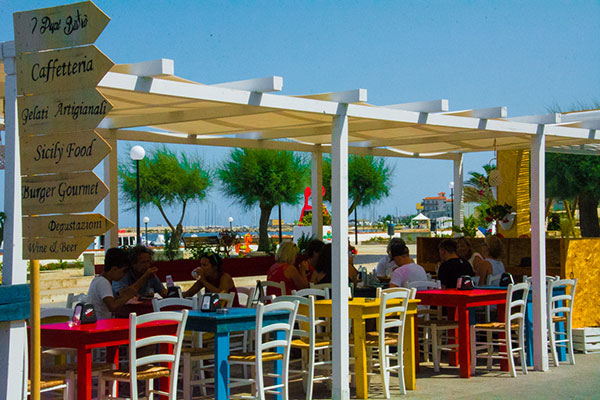
After sightseeing we went for a light lunch with wine tasting at Villa Giulia, a country manor in the Sicilian countryside. Villa Giulia is a very quiet and elegant estate filled with oleanders, bougainvillea, thousand year old olive trees and jasmine. The old winemaking community has turned into a lush and high quality hotel however it didn’t lose the touch for making delicious wine. The hotel offers wonderful fresh food from fruits and vegetables grown at the property, fresh cheeses and delicious homemade breads typical from Sicily, which are served in the hotels gorgeous dining room or outside on the terrace.
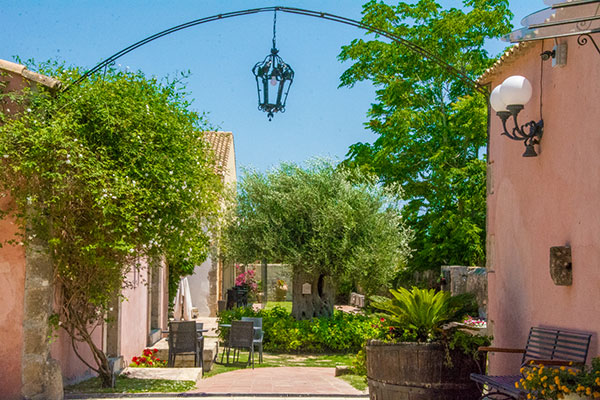
Visit the 'home of Inspector Montalbano' at Punta Secca; an enchanting sea side town offering lovely landscapes and clear seas. The setting is so picture-perfect that the TV channel RAI uses Punta Secca as a film set for its series Inspector Montalbano. Previously a fishing village in the past but it’s now a well-known beach destination. Its white lighthouse – also featured on the TV series – defines the town’s skyline and its white and pastel coloured buildings make it a very pretty village.
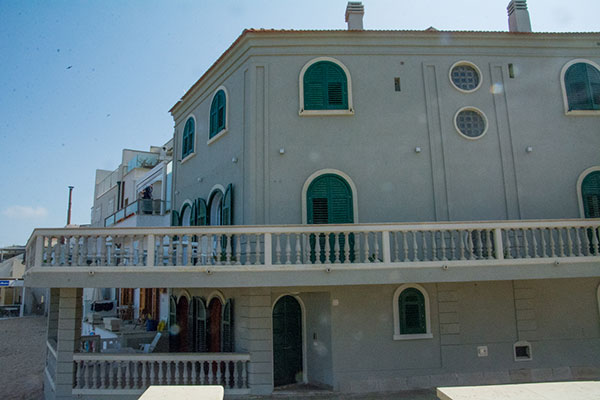
Modica is an attractive historic town, one of UNESCO-listed Baroque towns and is particularly famous for its chocolate which worth a try. It boasts some very fine Baroque architecture, picturesque views, such as the view overlooking the city from the eighteenth-century hilltop clock tower, and historic lanes.
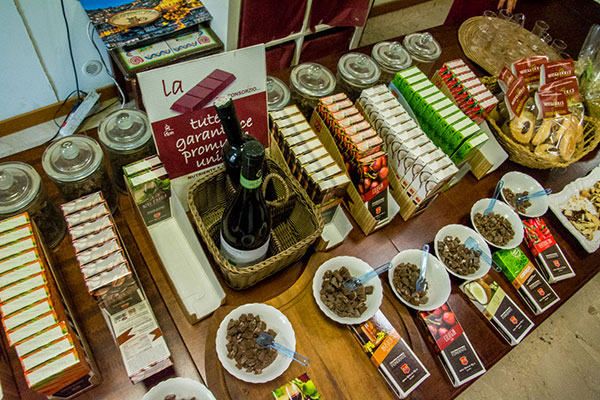
Scicli (in case you were wondering, is pronounced shi-kli) is less well-known than its neighbours (Ragusa, Noto and Modica) but just as fascinating with lovely churches including Sant’Ignazio, San Matteo, San Bartolomeo and Santa Marìa la Nova.
If you're a fan of the hit detective series Inspector Montalbano you will enjoy spotting familiar scenes; take a pleasant stroll down the beautifully conserved baroque street of Via Mormino Penna where you'll find the fictional police station from the TV series. The base from which Montalbano strived to work is actually the town hall of Scicli, and the fictional regional police HQ is a few steps away in Palazzo Iacono.
One of the most fascinating towns in Sicily, Ragusa is a town of two faces: on the top of the hill you will find Ragusa Superiore, further down the hillside you will be amazed by its magnificent historic centre Ragusa Ibla.
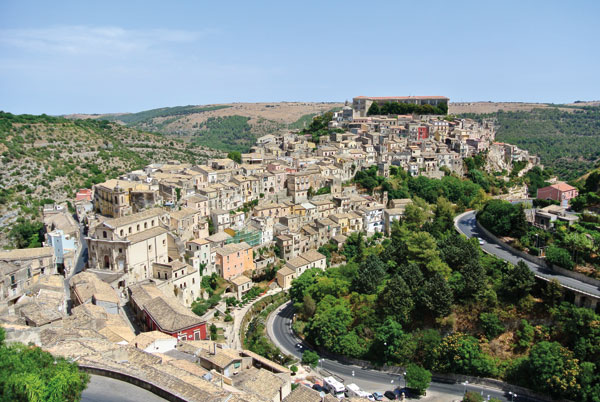
Ragusa Superiore is the 'modern' part of town with its elegant streets, nice shops and restaurants. It also has its own Duomo, the Cattedrale di San Giovanni Battista. The best part of the upper town is the descent, via the winding road or the steps, towards Ibla, the view from the upper town over Ragusa Ibla on its own separate hilltop appearing before your eyes is an unforgeable panorama, giving Ragusa the title of one of the most picturesque towns in Sicily.
Ibla is a charming area with tangled alleyways, baroque palaces, handsome squares and picturesque lanes. It is also one of the main filming locations for our favourite Sicilian detective drama; some of its scenes have been filmed at the Conversation Club where we have a private visit.
Not far away from Ragusa lies a beautiful 14th-century castle called Castello di Donnafugata (Donnafugata Castle), a pseudo-Venetian-Gothic country villa in the countryside. Those among you who love the series will recognise the building as it is featured in some episodes as the villa of Mafia boss Balduccio Sinagra.
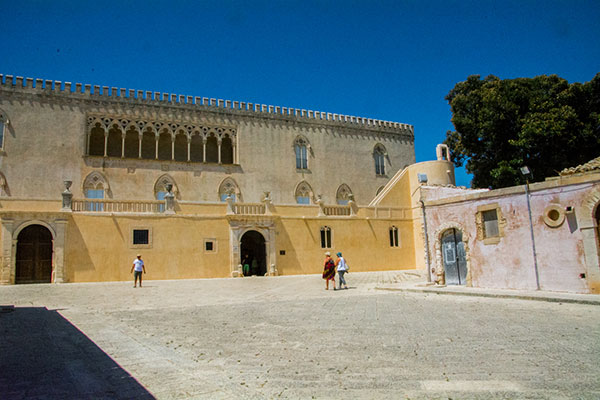
As my second visit to Sicily and probably not my last, this gorgeous island continues to seduce its visitors.





